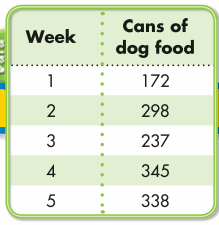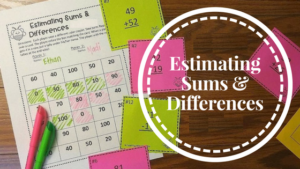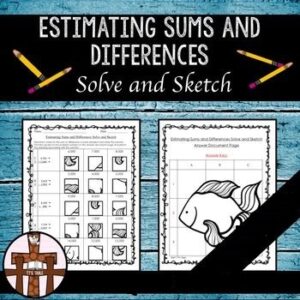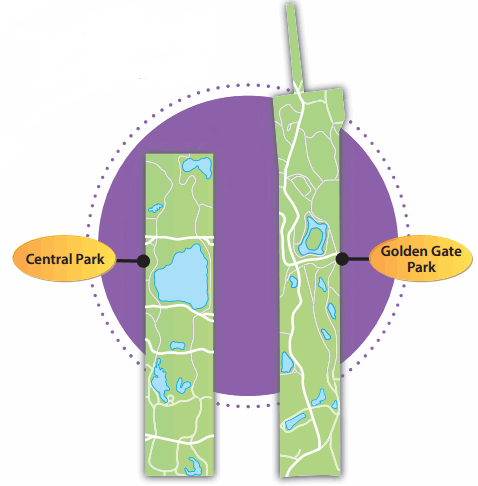Envision Math 5th Grade Textbook Answer Key Topic 2.3 Estimating Sums and Differences
How can you estimate sums?

Students are collecting cans of dog food to give to an animal shelter. Estimate the sum of the cans collected in Weeks 3 and 4.
Another Example
How can you estimate differences?
Estimate 22.8 – 13.9.
One Way
Round each addend to the nearest whole number.

22.8 – 13.9 is about 9.
Another Way
Substitute compatible numbers.

22.8 – 13.9 is about 10.
Explain It
Question 1.
Which estimate is closer to the actual difference? How can you tell without subtracting?
Answer:
Question 2.
When is it appropriate to estimate an answer?
Answer:
Guided Practice*
Do you know HOW?
In 1 through 6, estimate the sums and differences.
Question 1.
49 + 22
Answer:
Question 2.
86 – 18
Answer:
Question 3.
179 + 277
Answer:
Question 4.
232 – 97
Answer:
Question 5.
23.8 – 4.7
Answer:
Question 6.
87.2 + 3.9
Answer:

Do you UNDERSTAND?
Question 7.
Give an example of when estimating is useful.
Answer:
Question 8.
The students in the example at the top collected more cans of dog food in week 4 than in week 3. Estimate about how many more.
Answer:
One Way
Round each addend to the nearest whole number.

237 + 345 is about 500. The students collected about 500 cans of dog food in Weeks 3 and 4.
Another Way
Substitute compatible numbers.
Compatible numbers are easy to add.

237 + 345 is about 600. The students collected about 600 cans of dog food in Weeks 3 and 4.
Independent Practice
In 9 through 24, estimate each sum or difference
Question 9.

Answer:
Question 10.

Answer:
Question 11.

Answer:
Question 12.

Answer:
Question 13.

Answer:
Question 14.

Answer:
Question 15.

Answer:
Question 16.

Answer:
Question 17.

Answer:
Question 18.

Answer:
Question 19.

Answer:
Question 20.

Answer:
Question 21.
3,205 – 2,812
Answer;
Question 22.
93 – 46
Answer;
Question 23.
1,052 + 963
Answer:
Question 24.
149 – 51
Answer:
In 25 through 39, estimate each sum or difference.
Question 25.

Answer:
Question 26.

Answer:
Question 27.

Answer:

Question 28.

Answer:
Question 29.

Answer:
Question 30.

Answer:
Question 31.

Answer:
Question 32.

Answer:
Question 33.
77.11 – 8.18
Answer:
Question 34.
35.4 – 7.8
Answer:
Question 36.
89.66 – 27.9
Answer:
Question 37.
22.8 + 49.2 + 1.7
Answer:
Question 38.
67.5 – 13.7
Answer:
Question 39.
$9.10 + $48.50 + $5.99
Answer:
Problem Solving
Question 40.
Writing to Explain The cost of one CD is $16.98, and the cost of another CD is $9.29. Brittany estimated the cost of these two CDs to be about $27. Did she overestimate or underestimate? Explain.
Answer:
Question 41.
Martha cycled 14 miles each day on Saturday and Monday, and 13 miles each day on Tuesday and Thursday. How many miles
did she cycle in all?
Answer:
Question 42.
One fifth-grade class has 11 boys and 11 girls. A second fifth-grade class has 10 boys and 12 girls. There are 6 math teachers. To find
the total number of fifth-grade students, what information is not needed?
A. The number of girls in the first class.
B. The number of boys in the first class.
C. The number of math teachers.
D. The number of boys in the second class.
Answer:
Question 43.
On vacation, Steven spent $13 each day on Monday and Tuesday. He spent $9 each day on Wednesday and Thursday. If Steven brought $56 to spend, how much did he have left to spend?
Answer:
Question 44.
Estimate 74.05 + 9.72 + 45.49 by rounding to the nearest whole number. What numbers did you add?
A. 75, 10, and 46
B. 74.1, 9.7, and 45.5
C. 74, 10, and 45
D. 75, 10, and 50
Answer:
Question 45.
Golden Gate Park is located in San Francisco, California. The park covers 1,017 acres and has been compared to the size and shape of Central Park in New York City. Central Park covers 843 acres. About how many more acres does Golden Gate Park cover than Central Park?

Number Patterns
Example:
What are the next two numbers in the pattern?
24, 29, 28, 33, 32, 37, 36, …
Think The first number is increased by 5. The next number is decreased by 1. I see that the pattern continues.

To find the next two numbers, add 5, and then subtract 1. The next two numbers are 41 and 40.
The following numbers form a pattern.
3, 7, 11, 15, 19, …
In this case the pattern is a simple one.
The pattern is add 4.
Some patterns are more complicated.
Look at the following pattern.
20, 24, 30, 34, 40, 44, 50, …
In this case, the pattern is add 4, add 6.
Look for a pattern. Find the next two numbers.
Question 1.
9, 18, 27, 36, 45, …
Answer:
Question 2.
90, 80, 70, 60, 50, …
Answer:
Question 3.
2, 102, 202, 302, …
Answer:
Question 4.
26, 46, 66 , 86, …
Answer:
Question 5.
20, 31, 42, 53, 64, …
Answer:
Question 6.
100, 92, 84, 76, 68, …
Answer:
Question 7.
1, 3, 9, 27, …
Answer:
Question 8.
800, 400, 200, 100, …
Answer:
Question 9.
20, 21, 19, 20, 18, 19, 17, …
Answer:
Question 10.
10, 11, 21, 22, 32, 33, …
Answer:
Question 11.
25, 32, 28, 35, 31, 38, …
Answer:
Question 12.
5, 15, 10, 20, 15, 25, 20, …
Answer:
Question 13.
The following numbers are called Fibonacci numbers.
1, 1, 2, 3, 5, 8, 13, 21, 34, 55, …
Explain how you could find the next two numbers.
Answer:
Question 14.
Write a Problem Write a number pattern that involves two operations.
Answer:
